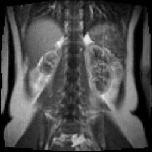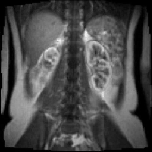

The goal of this work is to remove the motion in a DCE-MRI (dynamic contrast enhanced magnetic resonance imaging) sequence so that pure temporal changes in a chosen tissue can be investigated to detect potential pathology. To remove the motion, all images in the sequence must be registered to a template of some kind. The task is complicated by intensity modulations. Specifically, the following two images are taken from an image sequence


at a moment when, in addition to a displacement of pixels, a sudden local change in intensity has occurred through the appearance of contrast agent. Also, intensities are gradually varying in many objects of the images shown above. Ideally, each image could be segmented to allow the objects in them to be match. However, segmentation is also complicated by the intensity variations shown here.
On the basis of the example shown above, the image similarity measure used for the needed registration should not be based purely upon intensity differences or upon intensity level sets. Also, similarity measures based purely upon matching edges lead to weak force fields driving the registration. An objective is to develop a strong similarity measure which explicitly incorporates intensity variations. The approach investigated here uses a segmentation method which identifies natural objects in spite of such intensity variations.
Images in a sequence are registered pairwise, one pair after another. Let two images to be registered be denoted by I0 and I1. Let the displacement field be denoted by u, which is determined by minimizing the sum of an image similarity measure and elastic potential energy:
![∫ ∫ [ ]
J(u) = [I0(x+ u(x))- R [I1](x)]2dx+ λ|∇ ⋅u(x)|2 + 12μ|∇u (x )T + ∇u (x)|2 dx
Ω Ω](keeling2x.png)
Here, R[I1](x) in the image similarity measure is determined from the following average values over segments S of I1,
 = I1(S)+ ∫-S [I0(y + u(y))- I1(y)]dy, S ∈ Sd(I1)](keeling3x.png)
in a segmentation  d(I1) consisting of connected segments, each with the property that a polynomial of degree d fits the
intensities of I1 to a certain tolerance better than any other segment in the segmentation. The determination of the
segmentation is based upon a topological derivative approach to the Mumford-Shah functional. For the registration, J is
minimized by applying a Newton-type scheme.
d(I1) consisting of connected segments, each with the property that a polynomial of degree d fits the
intensities of I1 to a certain tolerance better than any other segment in the segmentation. The determination of the
segmentation is based upon a topological derivative approach to the Mumford-Shah functional. For the registration, J is
minimized by applying a Newton-type scheme.
Several other cost functionals have been investigated, particularly those with similarity measures based upon matching edges and those with penalties requiring less regularity for the displacement, and comparisons show the most natural elimination of motion obtained from the approach outlined here.